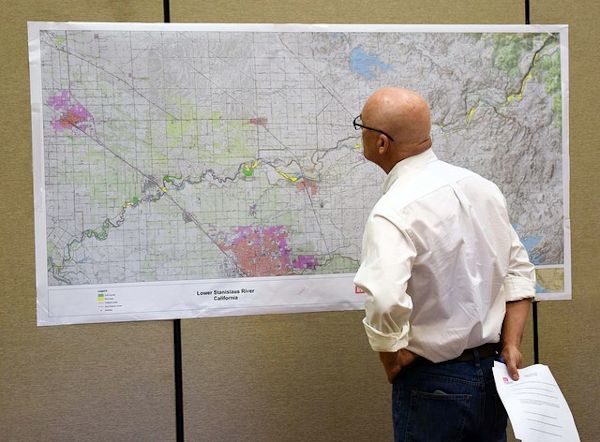SEJournal Online is the digital news magazine of the Society of Environmental Journalists. Learn more about SEJournal Online, including submission, subscription and advertising information.
 |
| An Oakdale, Calif., resident examines a map during a public meeting in June 2016 showing plans for Sacramento District parks and projects along the Lower Stanislaus River. The National Environmental Policy Act requires such projects prepare environmental impact statements, which are invaluable resources for reporters. Photo: U.S. Army/Paul Bruton |
TipSheet: Environmental Impact Statements a Key Tool for Reporters, But for How Long?
For more than four decades, the environmental impact statement has been among the best friends of journalists covering environment and energy. Now they are under attack.
The National Environmental Policy Act, or NEPA, requires any federal agency contemplating a major action to prepare a study of what its impacts on the environment would be — and to compare the impacts to those of possible alternative actions. The result is an often-long document chock-full of facts you don’t have to discover on your own the hard way.
NEPA became law on Jan. 1, 1970, marking the dawn of a key era of environmental concern and major legislation in the U.S. It covers major federal actions — which can certainly mean the construction of a dam or highway or sewage treatment plant.
But it can also mean the issuance of a federal permit, and since those permits may be required of local governments or private companies, NEPA’s reach stretches well beyond federal projects.
Not every project is “major” enough, though, to require a full EIS. Sometimes only the less rigorous environmental assessment is needed, or nothing at all.
Long court struggles over the adequacy of EISs are common. Sometimes, when a local group opposes a project for non-environmental reasons (e.g., “not in my backyard’), they will use NEPA as a tool to obstruct or delay the project. But not always.
Whatever the bona fides of the objectors, however, courts usually make fair and factual decisions, and any valid environmental concerns are considered. Those court fights are conflict, and conflict is news.
So the mere fact that an EIS is being prepared should signal you that news may be in the offing.
A key reporting tool and resource
Even just as a reporting tool, EISs are priceless. They are generally prepared by professional environmental analysts who know what they are talking about and are trying to write a document objective enough to stand up in court.
In a typical action, a “draft” EIS is prepared by the lead agency contemplating an action. The draft is then put out for public comment, sometimes at public meetings. Sometimes the meetings are boring; sometimes they are overcrowded with angry people who want to be on TV. Sometimes those people are concerned about environmental impacts that should have been considered, but haven’t been.
Environmental reporters are advised that
this great resource is endangered and
may not be around in current form forever.
The draft EIS also goes to other agencies with their own viewpoints on the project — more potential conflict. When an EIS goes “final,” it usually means the lead agency is ready to move ahead with the project.
Keep in mind that EISs often have decent graphics, which (because they are in a government document) are public domain. You can use these directly (remembering to credit the agency) or have your art department make them better. Editors like this.
EISs also have citations, which make a fact-checker’s job easier.
How to track down an EIS
One big trick is knowing that the EIS is in the works.
If you are a dedicated environmental beat reporter (so scarce nowadays), you may in fact know about the proposed project because it is already news. So what you need to do with a newsy project is find out whether it has an EIS. Talk to the relevant agency.
But if you want to canvass for news before it rears its head, try watching databases, the Federal Register (or state equivalent) or even the public notices.
The U.S. Environmental Protection Agency has been designated the clearinghouse for EISs. Every week, EPA publishes in the Federal Register the notices of availability for all EIS filings by all federal agencies.
Hint: Once you have the Federal Register notice on your screen, you can search the text for any keywords that might produce projects of interest to you, like the name of your state or town.
One way to get there is to go to the daily Federal Register page, click the “Current Issue” button, and then scroll down to EPA. Or go to the same daily Federal Register page, and enter into the search field: “Environmental Impact Statements; Notice of Availability.”
Another way, possibly even better, is to use the federal site known as regulations.gov. Try entering the same search term there. Lately, these seem to have been coming out on Tuesday.
There are a number of ways of getting your hands on an actual copy of the EIS. You can request it from the contact person at the originating agency (listed on the availability notice). Or, perhaps the geekier way, you can get it from the EIS database maintained by EPA. It is handy because it is searchable by geographic area.
More about EISs
- Under NEPA, top-level oversight of the EIS process resides in the White House Council on Environmental Quality, or CEQ. This makes it political — after a year in office, President Donald Trump just pulled (may require subscription) his nominee for CEQ chair because of political opposition.
- A key feature of Trump’s purported “infrastructure” program is the gutting of CEQ’s EIS process (may require subscription). So environmental reporters are advised that this great resource is endangered and may not be around in current form forever. Use it or lose it. Better yet, journalists may want to defend it.
- NEPA currently has some of the strongest and most proactive public disclosure requirements of any federal law or program. These are embedded not only in the text of the law, but in the CEQ regulations implementing it.
* From the weekly news magazine SEJournal Online, Vol. 3, No. 7. Content from each new issue of SEJournal Online is available to the public via the SEJournal Online main page. Subscribe to the e-newsletter here. And see past issues of the SEJournal archived here.













 Advertisement
Advertisement 



